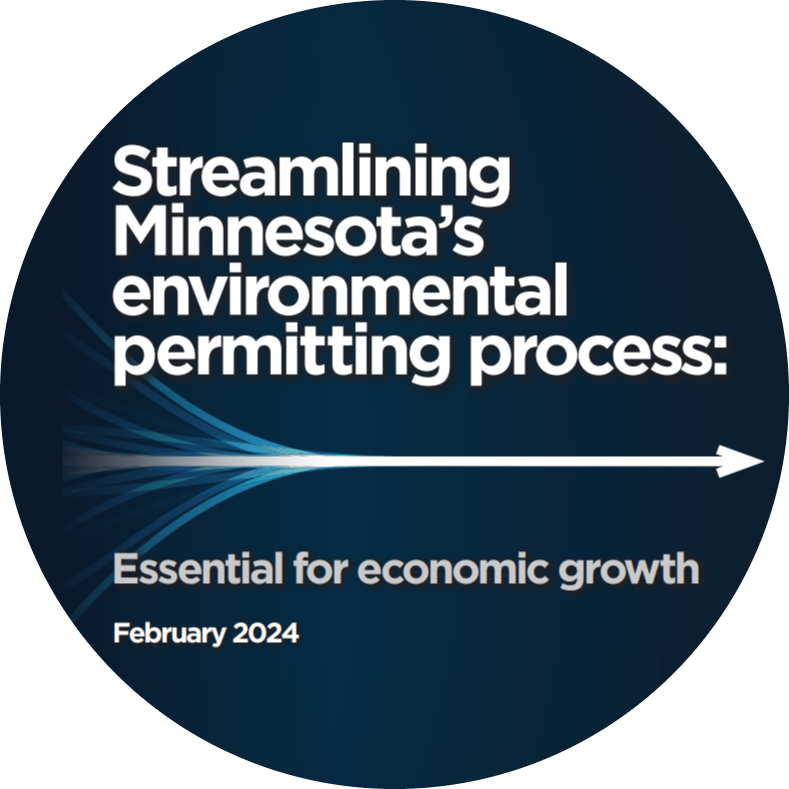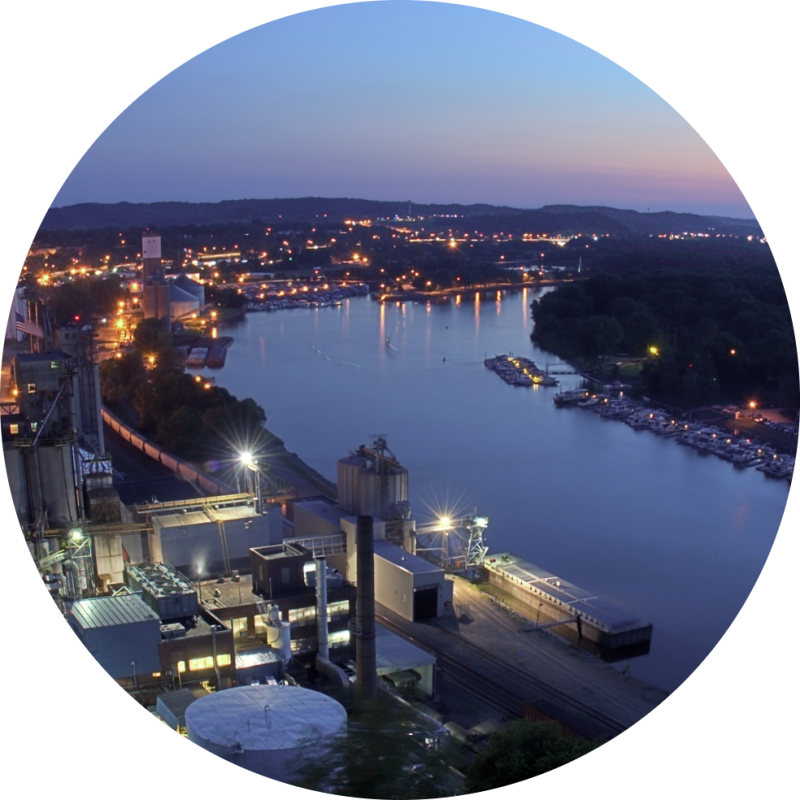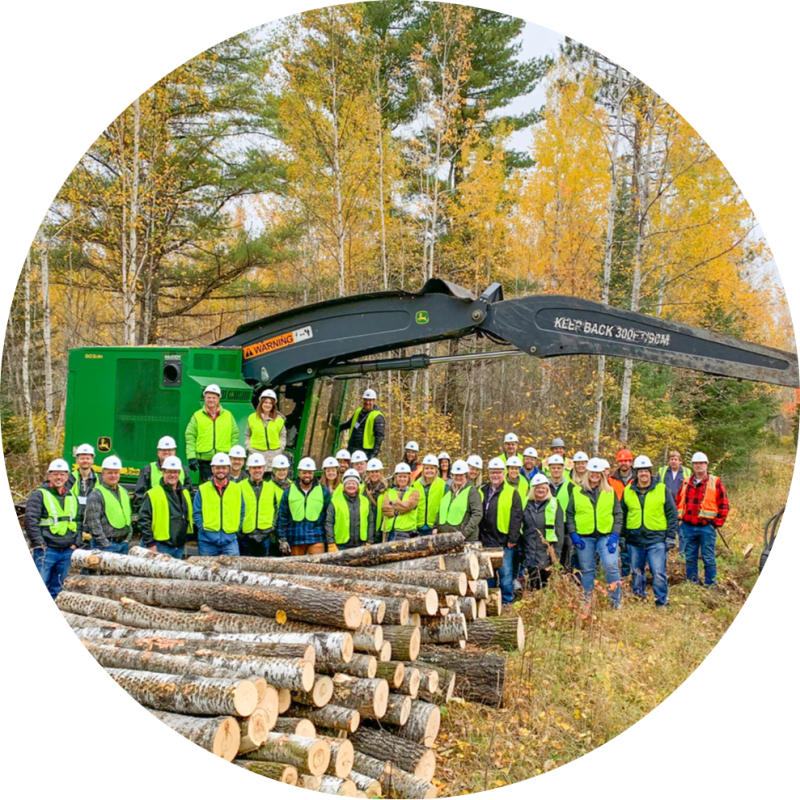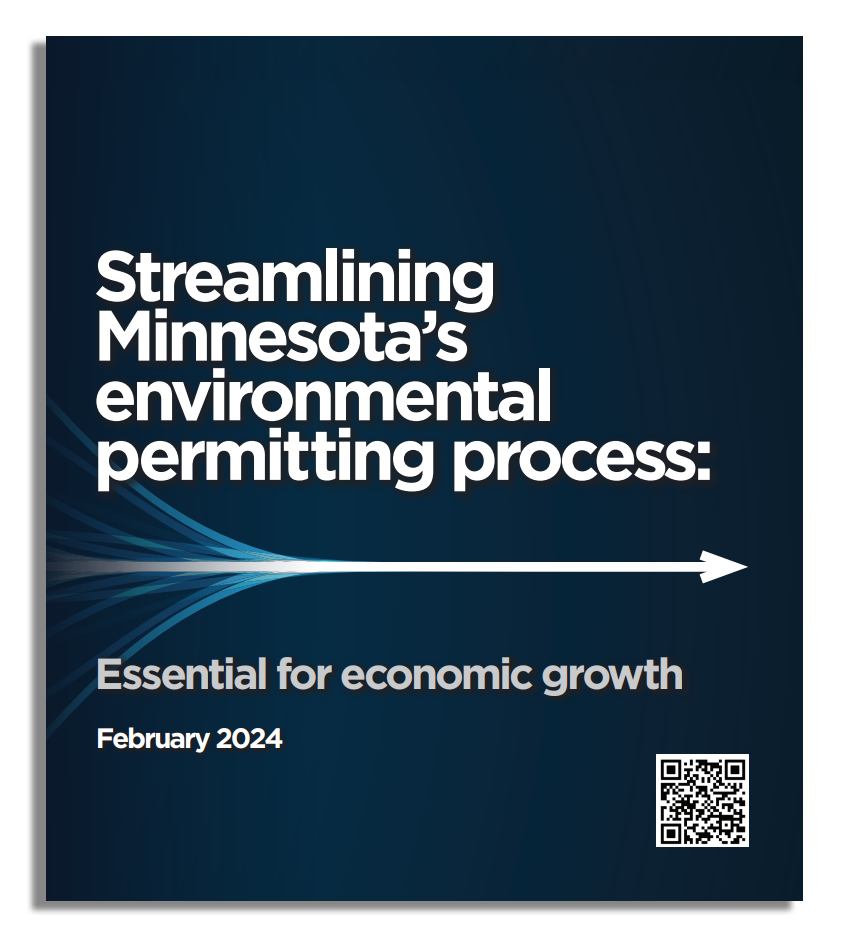Streamlining Minnesota’s environmental permitting process: Actionable strategies to improve timeliness and certainty
Air permitting
- Review and revise approach to completeness evaluations.
- Provide additional support for permit applicants.
- Use a separate construction and operating permit program.
- Review and revise expedited permitting options.
- Encourage applicants to use Tier 1 permitting options when possible or consider expanding the existing registration and capped permitting programs.
- Continue to expand online air permitting services, while soliciting and acting upon user feedback to improve user experience and reliability.
- Review and potentially address the permitting queue of “old” air permit applications (applications that have not been assigned but were received more than 365 days ago).
- Make air permitting data more accessible to permittees and the public.
Water permitting
- Further prioritize commitment to permit issuance timelines.
- Find opportunities for the MPCA to improve process efficiency.
- Develop an online resource for water permitting data.
- Reduce regulatory complexity.
Wetlands
- Complete the 404 assumption process.
- Expand the BWSR annual LGU report to include timing on completeness review and decisions.
- Revise Minnesota Statute 15.99 Subdivision 3(f) to be clear about the maximum number of times a RGU can extend the initial 60-day decision timeframe for WCA determinations.
Environmental Review
-
Improve transparency of Environmental Review timelines and outcomes.
- Narrow the focus on the required EAW content.
- Align the mandatory EIS Process with NEPA.
Air permitting
1. Review and revise the approach to completeness evaluations.
GOAL: This could help reduce the overall perceived duration of the air permitting approval process and help get air permits assigned to MPCA staff in a time-efficient manner.
A common perception among permitting consultants and applicants is that the MPCA staff conducting completeness reviews are exceedingly strict, and frequently the “deficiencies” identified are minor issues that could easily be resolved with a brief conversation. The MPCA could encourage these staff to contact applicants before deeming an application incomplete, and potentially reduce rework for both the applicant and MPCA staff. Permitting consultants and applicants theorize that there is more incentive for these MPCA staff to deem an application incomplete than to reach out and clarify potential misunderstandings. It is not clear whether this is intentional, but this report recommends that the MPCA investigate this further. The MPCA could also relax the criteria that trigger an incomplete application.
2. Provide additional support for permit applicants
GOAL: This could provide support and additional transparency to businesses and industries with questions regarding air permitting in Minnesota. It could also help support further transparency and accountability in the air permitting process for the MPCA.
The MPCA could provide more support for the regulated community and permit applicants by expanding the scope of existing small business ombudsman (supports businesses with less than 100 employees), or establishing a separate permitting ombudsman to support permit applicants from businesses of all sizes.
3. Use a separate construction and operating permit program.
GOAL: This could help reduce the time it takes the MPCA to review and act on projects associated with construction or modification at a facility.
Illinois has one of the shortest average permitting issuance durations, and used to have a combined permitting program like Minnesota but now issues separate construction and operating permits. Many other states reviewed for this assessment were also identified as having separate construction and operating permit approvals. Permitting issuance durations could be shorter if the MPCA issued separate construction and operating permits. A standalone construction permit could focus only on the new or modified equipment and could be a streamlined document compared to the combined (construction and operating) permits the MPCA currently issues. A shorter, more focused document may provide benefits to the general public, applicant and the MPCA. This approach could improve the general public’s understanding of air permits and enable more meaningful public engagement, allow permit holders to review and understand permit requirements more readily, and support more timely permit processing by the MPCA.
4. Review and revise expedited permitting options.
GOAL: This would help improve permitting timeliness for time-sensitive projects that may have a positive economic impact on Minnesota.
MPCA could review how well their expedited permitting program is working by tracking data and analyzing it along with other data in the Annual Permitting Efficiency Report. The perception among permitting consultants and applicants is that the expedited permitting option is typically not available, and there is uncertainty regarding how quickly the application might be processed. A possible revision may include the MPCA utilizing qualified third-party consultants to support the review and evaluation of permit applications, prepare drafts and other supporting steps, while the MPCA retains the responsibility to approve and issue final permits. This approach, which is currently authorized under current state statutes, could result in an expediting mechanism that is consistently available to applicants and reduces the application review time.
5. Encourage applicants to use Tier 1 permitting options when possible or consider expanding the existing registration and capped permitting programs.
GOAL: The MPCA processes Tier 1 air permit applications in a timely and efficient manner. While not all facilities or projects can meet the eligibility requirements of these Tier 1 program, expanded use of the permitting mechanisms could improve the efficiency of air permit issuances.
Over the last ten years, the MPCA has issued ~70-90% of Tier 1 applications within the 90-day goal, based on data from the MPCA’s “Air Permit Applications Received” dashboard. However, in the last ten years, the MPCA has only issued ~2- 18% of Tier 2 applications within the 150-day goal, based on data from the MPCA’s “Air Permit Applications Received” dashboard. MPCA could consider developing a streamlined permitting option to allow changes that are environmentally beneficial to proceed more quickly. Replacing an older control device with a state-of-the-art new device often requires a major permit amendment. In addition to the existing registration and capped permit programs, the MPCA could also evaluate implementing a permit by rule process for small, uniform sources to provide an efficient authorization mechanism as observed in other states.
6. Continue to expand online air permitting services while soliciting and acting upon user feedback to improve user experience and reliability.
GOAL: To increase efficiency in the electronic submittal process if developed and executed in a way that provides flexibility to applicants while ensuring the MPCA gets the information required to review an application.
Electronic permit application submittals could help streamline administrative and completeness reviews. However, the expansion of electronic application submittals should be investigated in partnership with industry to ensure that any new processes do not increase undue complexity of application preparation. Applicants and permitting consultants assisting with online applications for Title V renewals through Tempo – the agency’s permitting data management system – have experienced technical challenges, particularly for “larger” facilities with many emission units or control equipment.
7. Review and potentially address the permitting queue of “old” air permit applications (applications that have not been assigned but were received more than 365 days ago).
GOAL: To help the MPCA prioritize current and future applications in a timely and efficient manner.
According to the MPCA permitting dashboard, as of November 6, 2023: MPCA had approximately 371 applications awaiting assignment; approximately 25% (91 of 371) were received less than 365 days ago; the remainder (280 of 371) have been awaiting assignment for anywhere from 1-30 years. Approximately 134 applications are 1-5 years old, 87 are 5-10 years old, and 59 are greater than 10 years old.
MPCA could take a screening approach and attempt to contact the applicants to determine whether any of the applications are no longer needed or relevant. Similarly, the MPCA should consider setting time limits for non-priority permit renewals to ensure that companies can operate with the assurance of operating within an active and up-to-date air permit.
8. Make air permitting data more accessible to permittees and the public.
GOAL: This would improve transparency and efficiency insights for all included environmental permitting programs.
Air permitting dashboard: This resource provides ertain details important to air permit applicants and the public—however, additional information could be collected to provide a more comprehensive representation of the permitting process. Examples of additional details to include are: a summary of statistics of applications awaiting assignment and issued permits; identification of priority and non-priority applications; schedules and deadlines, among others as outlined in this report. (See the full report for a complete set of recommended changes to “Air Permit Applications Received” dashboard.)
Annual Permitting Efficiency Report: This report does not fully portray the status of air permit application processing in Minnesota. It could be improved to show how well permit application review is going for each group or division that issues permits. The MPCA receives far more Tier 1-priority-water permit applications than any other type; as a result, the MPCA’s Annual Permitting Efficiency Report is driven by the data from this category of permit applications. This makes it difficult to discern how efficiently other types of permit applications are processed. This report should also assess all permits issued in the fiscal year, not just those received in the current fiscal year to better highlight timeliness. (See the full report for a complete set of recommended changes to Annual Permitting Efficiency Report.)
Water permitting
1. Further prioritize commitment to permit issuance timelines.
GOAL: These changes could result in more timely permitting (shorter permitting timelines) with benefits including permittees able to start projects or new activities sooner, increased schedule certainty for permittees and current permits with up-to-date requirements that are more straightforward to modify for future projects.
Of the 15 priority individual industrial NPDES/ SDS permit applications received by the MPCA in fiscal years 2018 through 2023, only the requests for minor permit modifications were completed during the MPCA’s 150-day goal timeframe. Permitting timeframes for completed priority permit issuances, reissuances and major modifications were an average of 476, 667 and 377 days, respectively.
Addressing this issue will require leadership support for timely issuance and reissuance of permits, while also preserving the ability to modify schedules as appropriate to work through complicated issues with permittees. This would provide increased schedule certainty for permittees, especially for those that need a permit action prior to new or expanded activities.
Some examples that could aid this process are:
- Requiring permit writers to consistently provide regulatory-required notifications to permittees (e.g., notification within 30 business days of application related to application completeness and whether a permit can be issued within the 150-day goal).
- Developing a plan to work through the significant backlog of administratively continued permits.
- Focusing additional agency staff on timely permitting through hiring of additional individuals and/or reprioritizing existing staff time.
2. Find opportunities for the MPCA to improve process efficiency.
GOAL: More timely permitting (shorter permitting timelines) with benefits as previously discussed.
Opportunities such as evaluating the number of agency staff involved in the permitting process for an individual permit based on the complexity of the permit and aligning department leadership and staff involved in the permitting process would clarify oversight and decision rights. Experience indicates that the MPCA may involve more internal parties in the development of individual industrial NPDES permits than other states.
3. Develop an online resource for water permitting data.
GOAL: Implementing a similar online resource would improve transparency and increase understanding of schedule and progress.
Develop an online resource for tracking the status of NPDES permit applications within the permitting process. The MPCA has a dashboard for tracking air permit application statuses and several benchmark states have online resources for tracking NPDES permit application statuses.
4. Reduce regulatory complexity.
GOAL: More options for streamlined and efficient permitting. Increased ease of navigating permitting process.
Examples include:
- Developing additional general permits for similar operations and types of discharges.
- Clarifying and streamlining antidegradation procedures to remove barriers for potential and existing permittees (review well-established procedures in states such as Iowa, Michigan and North Dakota to identify potential opportunities).
- Developing guidance and tools to assist both agency staff and permittees with ways to efficiently and effectively navigate Minnesota’s permitting process, complex water quality criteria and significant number of impaired waters.
General permits are typically a more streamlined and standardized permitting option than individual permits. Minnesota has 11 general permits available for permittees to apply for coverage under compared to the benchmark state average of 16 general permits. The NPDES permitting process steps are relatively similar across states; however, the details of how steps are conducted, who is involved, timelines, and prioritization may vary from state to state. The most noticeable process differences are associated with antidegradation procedures, which are a more substantial procedural hurdle to navigate in Minnesota than in states with well-established procedures. There are generally more water quality considerations (e.g., water quality criteria, impaired waters) to be navigated by permittees and the agency in Minnesota than there are in other states.
Wetlands
1. Complete the 404 assumption process.
GOAL: Reduce duplication between Water Conservation Area (WCA) and the USACE.
Michigan assumed authority to implement Section 404 of the Clean Water Act. Therefore, separate authorization from USACE is not required for wetland impacts unless they are adjacent to Section 10 waters (the Great Lakes and typically larger rivers discharging to the Great Lakes).
2. Expand the Minnesota Board of Water and Soil Resources (BWSR) annual LGU report to include timing on completeness review and decisions.
GOAL: Further evaluation of effectiveness of specifically administering WCA to understand the actual decision timeframes and to help identify areas for improvement.
The BWSR annual report does not currently specify timing of completeness review or decisions.
3. Revise Minnesota Statute 15.99 Subdivision 3(f) to be clear about the maximum number of times a RGU can extend the initial 60-day decision timeframe for WCA determinations.
GOAL: Improve timeliness for WCA determinations and provide project proponents more certainty regarding the time it takes to complete the process.
Minnesota Statute 15.99 Subdivision 3(f) does not specify how many times an RGU can extend their decision timeframe.
Environmental Review
1. Improve transparency of Environmental Review timelines and outcomes.
GOAL: To allow for more detailed evaluation of potential opportunities for improvements to the process, better understanding of timelines for specific project types, as well as improved ability to measure the performance of RGUs.
The 2011 OLA report supports this recommendation and notes such data are critical to an objective assessment of the amount of time these processes take and identification of systemic issues that may need improvement (reference). The Environmental Quality Board (EQB) should be responsible for compiling this data rather than relying on each individual local and state agency RGU to publish its own information.
Update the EQB’s Environmental Review Projects Database to include additional statistics that would provide transparency regarding the actual timelines to complete an environmental review. The statistics should include each step of the process for an EAW or EIS, following the flow charts presented in Section 5.4.1.1. At a minimum: date when an RGU first receives an EAW or AUAR from a project proponent, date when an RGU deems the EAW or AUAR complete for publication, date of EIS need determination, date of EIS preparation notice and date of EIS adequacy decision.
The database should include the ability to export and summarize the data by project type and RGU. Furthermore, Minnesota could consider development of a program like FAST-41 administered by the EQB for complex projects. The EQB could coordinate with local, state, and federal entities/agencies to identify authorizations required, establish a timetable for environmental review/permitting, and track progress via a publicly available website. This would provide greater transparency for the public and project proponents regarding the processes and timeframes. EQB could incorporate this concept within its database in addition to the items noted above. The EQB database does not provide summary statistics regarding timelines for projects to complete environmental review. Such summary statistics could be generated by manually extracting the information from each individual project listed when there is a more sizable dataset available. In addition, it does not appear that the EQB or other RGUs maintain publicly available data that summarizes the timeline for the RGU to deem an EAW complete, which is an important step in the process and can vary. Therefore, there is not a readily available public data set that provides the entire timeframe for projects starting and completing environmental review.
2. Narrow the focus on the required EAW content.
GOAL: Reduce duplication between environmental review and permitting that could improve timeliness.
Narrow the required EAW content to only those questions where the impacts would not require permits (i.e., subject to the mitigation of an ongoing authority or the impacts are subject to permits that do not have public comment/engagement as part of the process). Permit applications often require more detailed information and analysis than an EAW for specific resource areas such as air (Section 5.1.1) and water (Section 5.2.1).
3. Align the mandatory EIS Process with NEPA.
GOAL: To provide project proponents more certainty regarding the time it takes to complete the environmental review process.
If a mandatory EIS is necessary, eliminate the scoping EAW, and instead, align the scoping process with NEPA (40 CFR 1501.9 currently, 1502.4 in the pending regulations) where an EAW is not a necessary precursor to an EIS. In addition, amend Minnesota Rules Chapter 4410.2100 to set a maximum time limit for the RGU to complete the scoping process like the requirement for determination of a final EIS within 280 days of the publication of the preparation notice.
The RGU has 280 days from publication of the preparation notice to make an adequacy determination on the final EIS unless the project proponent agrees to an extension, or the governor allows for more time (Minnesota Administrative Rules Chapter 4410.2800, Subpart 3); however, there is no maximum time limit to complete the scoping process.






